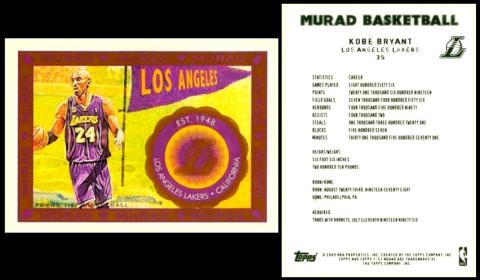
I wonder how many of us knew that that famous Murad "College Series" set which we featured yesterday was re-imagined by Topps? If not, here it is. It is heartening that they pay tribute to the original with the name, and even, quite wonderfully, by including Jefferson Burdick`s "T.51" code as part of the title.
However, I have to wonder how many modern collectors have ever taken the time to think for a moment on why that code is there, and what it represents, let alone to go off and look it up online. I did that though, and it is hard to find any mention of Jefferson Burdick, or the original set, most of it is about body armour used in "Fallout". Even looking T.51 up on Wikipedia only brings you to links concerning aviation, motoring, wheelchair racing and computing. It is only when you add the word "Murad" that the Topps set pops up, along with the original, if you scroll further down.
This card that has been chosen to represent the set for you is especially poignant, as it shows Kobe Bean Bryant, who played for the Los Angeles Lakers for the whole of his career, twenty years, and won Olympic gold medals in the team event. He also won an Academy Award - "Best Animated Short" for a lovely tribute film to the sport that he so loved.
Sadly, he was killed in 2020, along with several others, including his daughter, in a helicopter crash.
His father, Joseph Washington Bryant is still alive, and he was also a basketball player, for several teams, in America and in Europe, as well as a coach, in America, Europe, and Asia. He also appears on cards, though not quite so many as his son. You can see this for yourself at The Trading Card Database Joseph Bryant and Kobe Bryant
This set, like most modern sets, is not just a base set, there are lots of variety cards, which you can explore at the Trading Card Database/ToppsT.51. And, thrillingly, in another nod to cartophily of yore, these additional items include a heark back to the days when "cards" were actually leathers, and silks, and even grew to such a size that they were regarded as cabinet cards, which, in this case, are also linked back to the original "Murad" versions by a "T.6" code.
